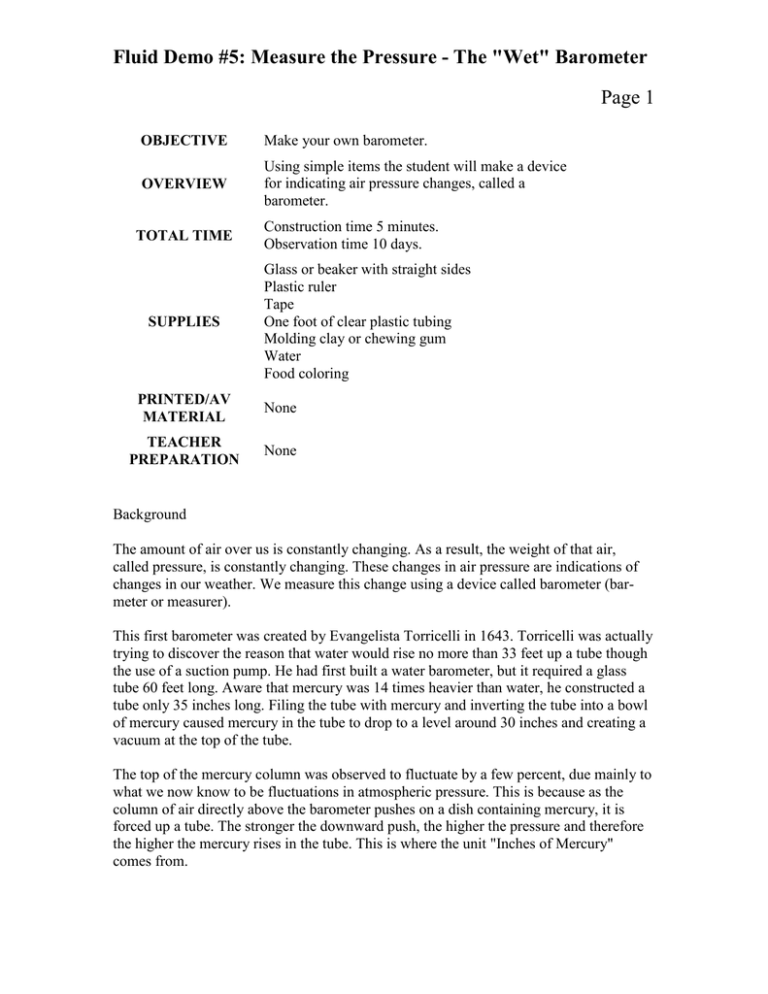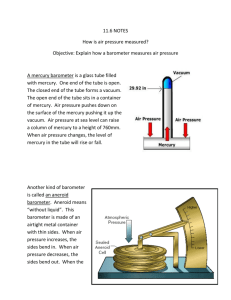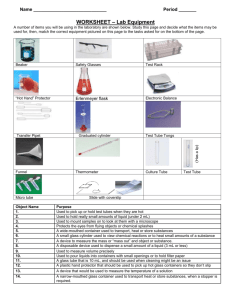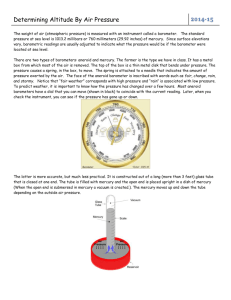Fluid Demo #5: Measure the Pressure - The "Wet" Barometer
advertisement

Fluid Demo #5: Measure the Pressure - The "Wet" Barometer Page 1 OBJECTIVE Make your own barometer. OVERVIEW Using simple items the student will make a device for indicating air pressure changes, called a barometer. TOTAL TIME SUPPLIES Construction time 5 minutes. Observation time 10 days. Glass or beaker with straight sides Plastic ruler Tape One foot of clear plastic tubing Molding clay or chewing gum Water Food coloring PRINTED/AV MATERIAL None TEACHER PREPARATION None Background The amount of air over us is constantly changing. As a result, the weight of that air, called pressure, is constantly changing. These changes in air pressure are indications of changes in our weather. We measure this change using a device called barometer (barmeter or measurer). This first barometer was created by Evangelista Torricelli in 1643. Torricelli was actually trying to discover the reason that water would rise no more than 33 feet up a tube though the use of a suction pump. He had first built a water barometer, but it required a glass tube 60 feet long. Aware that mercury was 14 times heavier than water, he constructed a tube only 35 inches long. Filing the tube with mercury and inverting the tube into a bowl of mercury caused mercury in the tube to drop to a level around 30 inches and creating a vacuum at the top of the tube. The top of the mercury column was observed to fluctuate by a few percent, due mainly to what we now know to be fluctuations in atmospheric pressure. This is because as the column of air directly above the barometer pushes on a dish containing mercury, it is forced up a tube. The stronger the downward push, the higher the pressure and therefore the higher the mercury rises in the tube. This is where the unit "Inches of Mercury" comes from. Fluid Demo #5: Measure the Pressure - The "Wet" Barometer Page 2 Procedure 1. Place the ruler in the glass and tape it to one side. (Make sure the numbers are visible.) 2. Tape the plastic tube onto the ruler in the glass. (Make sure the tube is not touching the bottom of the glass.) 3. Fill the glass about half way with water. Add a drop or two of food coloring and mix thoroughly. 4. Using the tube like a straw, draw some water about 2/3rds into the straw. 5. Using your tongue, trap the water in the tube then cap the end of the tube with model clay or chewing gum. 6. Record the height of the water in the tube. 7. At the same time every day, for the next 10 days, record the height of the water in the tube, paying close attention to the change in the weather as the water level changes. Discussion What the students have constructed is a water barometer (also known as "storm glass") and these types of barometers date from the 17th century. The actual change in pressure will occur too slow for direct observation. Usually, only for a 24 hour period will the change in pressure be most noticeable. As a storm approaches, the mass of air around your location decreases. Therefore, the pressure decreases as well. After a cold front passes your location, higher pressure moves in and the students will see the pressure rise. Over and above the pressure changes associated with storms, there are four daily pressure fluctuations in the atmosphere. These diurnal changes are due to the sun heating the atmosphere. The amplitudes of this daily change depend upon the latitude, season, and altitude. The changes are greatest at the equator, decreasing toward the poles where it becomes zero. Also, the higher the altitude, the greater the daily change. NOAA – National Weather Service






